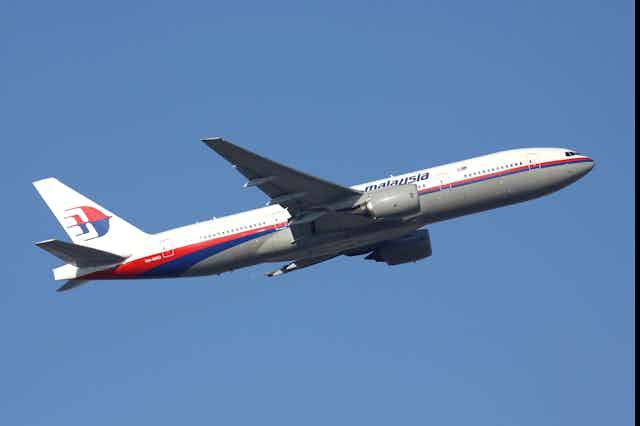Malaysian Airlines flight MH370 disappeared on March 8 2014 with 239 people on board. Despite extensive search efforts, the final location of the aircraft remains unknown. It has become one of aviation’s greatest mysteries.
Our new research explores the possibility of detecting underwater acoustic signals generated by aircraft crashes, such as MH370’s presumed impact, to provide new insights into its fate.
Flight MH370 was en route from Kuala Lumpur to Beijing when it vanished from radar screens. Official investigations suggest it deviated from its planned route, heading southwest over the Indian Ocean. Despite multinational search efforts, including extensive underwater searches along and near the so-called “seventh arc” (the area determined by last communication between the satellite and the plane), the main wreckage has not been found.
Only a few pieces of debris washed ashore on western Indian Ocean islands have been confirmed as belonging to MH370. This has left families of the passengers, search teams and the world grappling with unanswered questions.
Acoustic analysis
Hydrophones are underwater microphones which capture sound waves and pressure changes in the ocean. Such technology has shown promise in detecting pressure signals from various events, including aircraft crashes. These types of signals can travel thousands of kilometres, making hydrophones a valuable tool for identifying and classifying events in marine environments.
For our study, we analysed data from the Comprehensive Nuclear-Test-Ban Treaty Organization’s (CTBTO) hydroacoustic stations. We focused on data from stations at Cape Leeuwin in Western Australia and Diego Garcia, an island in the Indian Ocean.
Both locations were operational around the time MH370 is believed to have crashed. These stations are located within tens of minutes’ signal travel time from the seventh arc. CTBTO stations have previously detected distinctive pressure signals from aircraft crashes, as well as earthquakes of various sizes at distances of more than 5,000 kilometres away.
The mode of impact dictates the signal’s properties such as duration, frequency range and loudness. By examining these signals, we hoped to identify any potential acoustic evidence of MH370’s crash.

Previous analysis by scientists at Curtin University and later by us confirmed a signal of an unknown source recorded at Cape Leeuwin station, in the direction of the seventh arc. But it fell outside the time window suggested by the official search.
Our latest research focused on the official and narrow time window. The analysis identified only one relevant signal in the direction of the seventh arc, recorded at the Cape Leeuwin station. But this signal was not detected at the Diego Garcia station. This raises questions about its origin. We also examined data for signals along MH370’s initial flight path but found no corresponding acoustic signatures.
With only a handful number of past aeroplane incidents, our findings are not conclusive. But a 200-tonne aircraft crashing at a speed of 200 metres per second would release the kinetic energy equivalent to a small earthquake. It would be large enough to be recorded by hydrophones thousands of kilometres away.
Given the sensitivity of the hydrophones, it’s highly unlikely that a large aircraft impacting the ocean surface wouldn’t leave a detectable pressure signature, particularly on nearby hydrophones. But unfavourable ocean conditions could potentially dampen or obscure such a signal.
Controlled explosions
To help resolve the debate about the detectability of the acoustic signal from MH370, a practical approach could be to conduct controlled explosions along the seventh arc, similar to those done for the ARA San Juan submarine.
On November 15 2017 the ARA San Juan, operated by the Argentine Navy, went missing during an exercise mission. A few hours later an unusual signal was recorded by CTBTO stations. To help with the search, an air-dropped calibration grenade drop was conducted two weeks later near the last known location.
The calibration grenade, which was also recorded at the CTBTO hydroacoustic stations, was similar to the unusual signal that radiated from the submarine implosion. The submarine was found a year later with all 44 crew members lost.
A similar exercise, using either explosions or airguns of energy levels equivalent to those believed to be associated with MH370, could be conducted along the seventh arc. If the signals from such explosions showed pressure amplitudes similar to the signal of interest, it would support focusing future searches on that signal. If the signals detected at both Cape Leeuwin and Diego Garcia are much stronger than the signal in question, it would require further analysis of the signals from both stations.
This could also lead to a reassessment of the data used to determine the seventh arc, considering new scenarios based on updated findings. Additionally, variations in signal strength could provide insights into the conditions affecting the variability, potentially helping to better locate impact areas based on specific terrains and paths.
So, while our research does not pinpoint MH370’s exact crash location, it highlights the potential of hydroacoustic technology in solving this aviation mystery. By refining our methods and conducting further experiments, we could provide new insights into MH370’s fate and improve our response to future maritime incidents.
The ongoing efforts to locate MH370 not only seek to bring closure to the families affected but also to enhance our ability to track and understand aviation accidents over vast oceanic expanses.

